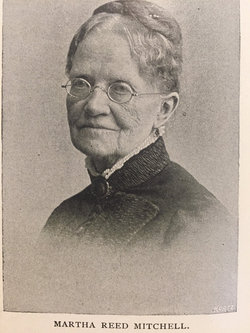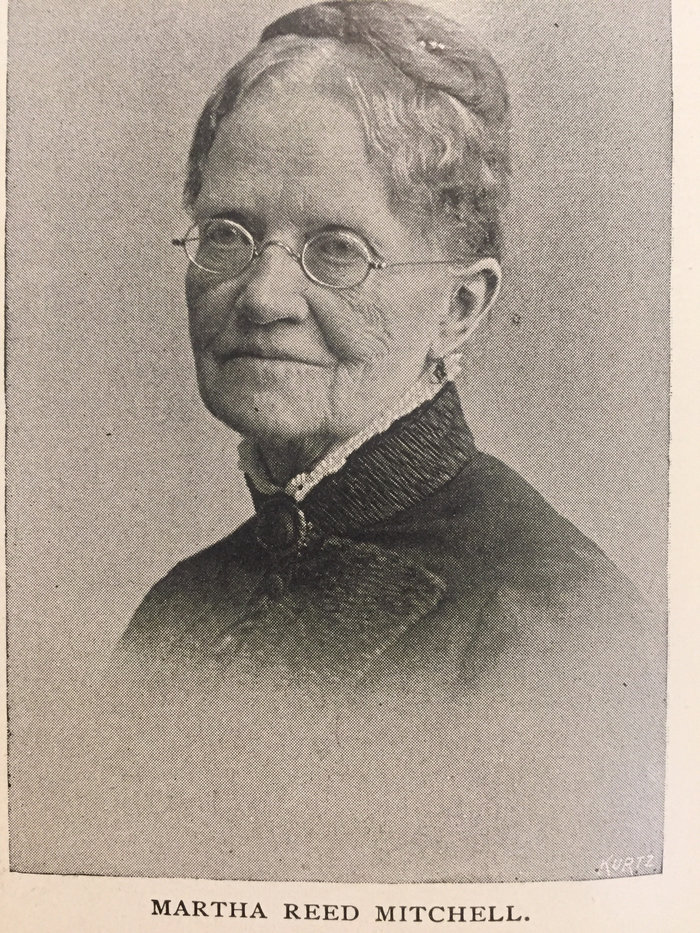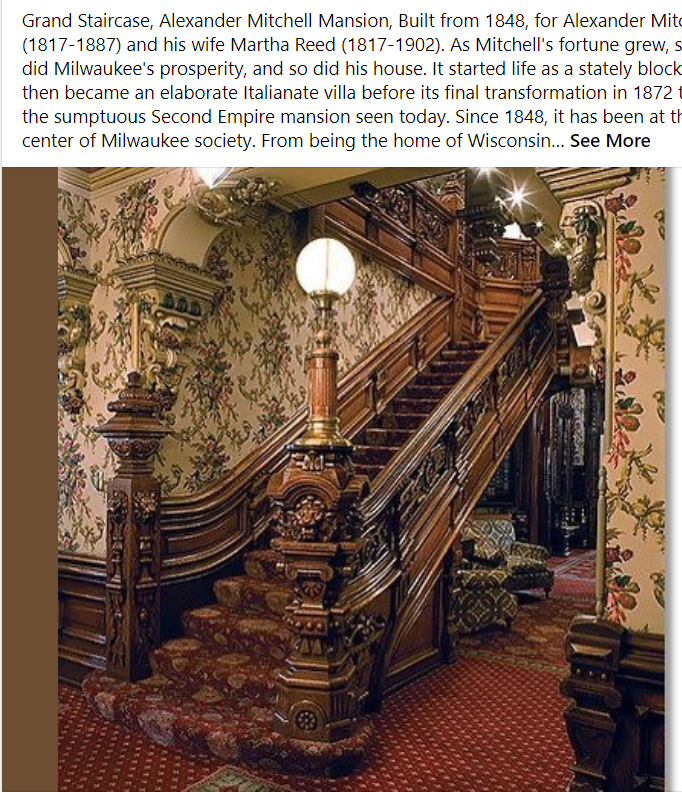Martha Reed Mitchell
Martha Reed was one of eight children born to Rhoda Finney (1781-1874) and Seth Harrison Reed (1781-1848). Her parents had lived in Massachusetts and Vermont and subsequently were early settlers in Milwaukee, Wisconsin. Her siblings included: Julia Ann (1806-1881), who married Thomas Jefferson Noyes; George, (1807-1883); Orson (1809-); Mary Augusta (1811-), who married Abram Daniel Smith (1811-1865); Harrison Jackson (1813-1899); and Curtis (1815-1895).
Mary Cunningham Logan, in her "The Part Taken by Women in American History" (Wilmington, Delaware: Perry-Nalle Publishing Co., 1912), writes that Martha Reed, was educated at Miss Fiske's School in Keene, New Hampshire and at Emma Willard's Troy Female Seminary in New York. She moved with her parents, Seth and Rhoda Reed, to Milwaukee, Wisconsin Territory, in 1838, a trip that took three weeks, traveling on the Erie Canal and the Great Lakes. It was in Milwaukee that Martha would meet and in 1841, marry Alexander Mitchell, a 23 year old Scotsman who had immigrated to the United States in 1839 to manage the newly organized Wisconsin Marine and Fire Insurance Company. A year later, Martha and Alexander's only child was born, John Lendrum Mitchell.
In 1848, her husband became a director of the Milwaukee and Waukesha Railroad, ultimately leading to his consolidation of multiple railroad lines and his presidency of the Chicago, Milwaukee and St Paul Railroad. In 1852, Alexander organized the Marine and Fire Insurance Bank, of which he became President and principal owner. In 1871, he was elected to the United States Congress to represent the 1st and 4th Districts of Wisconsin. He served until 1875. Martha's brother Harrison Reed was serving as Governor of Florida at the same time as her husband was a United States Congressman. Just prior to that time, another of Martha's brothers, George, an attorney and judge, had served in the Wisconsin state senate from 1865-1870. Another of her brothers, Curtis, had founded Menasha, Wisconsin in 1849 and held local offices of alderman, mayor, and postmaster.
Martha lost her husband in 1887. She was at Villa Alexandria when he succumbed to the flu in New York, after returning from their Florida home. At the time of his death, Alexander Mitchell was considered the wealthiest man in the Northwest, his wealth estimated at $20,000,000. He and Martha had an estate in Milwaukee, which was their principal residence, a mansion located between 9th and 10th Streets on Wisconsin Avenue, now known as the Wisconsin Club. They also had built a lavish estate on 140 acres in Florida on the banks of the St Johns River. This property was located where the River Road section of the San Marco area of Jacksonville would later be developed. They named this estate "Villa Alexandria." It included a three story frame mansion, stables, tennis courts, a polo field, orange groves, a swimming pool, and formal gardens. Martha had been drawn to the area when she visited her brother, Harrison Reed, in 1867, a year before he would take office as Governor of Florida.
Martha's husband and three brothers were not the only legislators in the family. Her son John Lendrum Mitchell represented Wisconsin in the United States Congress from 1891-1893 and then in the United States Senate from 1893 to 1899. He had married, had a son, and divorced and then married Harriett Danforth Becker and had seven children, one of whom was to become Martha's famous grandson, General William "Billy" Lendrum Mitchell. Billy Mitchell was an Army aviator who was ahead of his time in asserting that airpower would assume a major military role, rendering the surface fleet obsolete. He was awarded the Congressional Medal of Honor for his foresight in predicting the events of Pearl Harbor fifteen years before they happened.
During her lifetime, Martha was involved in many charitable activities. In Wisconsin, she organized the Protestant Orphan Asylum. She helped organize and served as first president of the Milwaukee Women's Club. She played a large role in opening the Milwaukee Soldiers' Home. In Jacksonville, she helped establish St Lukes Hospital and All Saints Episcopal Church.
In a 1936 interview for the Federal Writers Project, Mrs. Charles LeNoir described Martha Mitchell as "a tall, well-built woman, and very dignified in her manner and speech... Her eyes were blue. She was a woman of much culture, a world traveler and quite artistic." Mrs. LeNoir described a number of the rooms of Martha's Villa Alexandria mansion: "Mrs. Mitchell's own bedroom was very beautiful. It had a big bay window which faced the river. The windows in the room were hung with white silk curtains with over-drapes of heavy blue brocade. On one side of her bed she had a tall screen with three doors that folded. These doors were all full-length heavy mirrors, and the other side was of yellow plush. Three steps led up to her bedroom from the hall, which caused some people to remark - 'The steps led up to her throne.' The woodwork in the room was all decorated with hand-carvings. It was reported she had secured these carvings in France, had them carefully taken down and brought over here and installed in her room. All the little cabinets, the paintings on the walls were French, and there were many round and oval mirrors of French style. The dining room was a masterpiece of magnificence. It was quite large. The dining table occupied the center of the room, which could accommodate seventy-five guests. Cabinets were built in on two sides of the room, with glass doors, and in these were stored her magnificent imported china. In one was a marvelous collection of teapots from all over the world, patiently collected on her many trips abroad. Ordinarily the table was in the middle of the room, but when only a few guests were present, it was shoved up into the expansive bay window looking out upon the St. Johns River. Fine paintings by European masters adorned the walls of this room."
After her death, Martha's Villa Alexandria estate eventually fell into ruin. The mansion and all of the other buildings were demolished by a developer in 1927. The first lots in the new development were sold in 1929 to John and Carl Swisher, who built homes on the waterfront where Martha's mansion once had been.
Martha Reed Mitchell
Martha Reed was one of eight children born to Rhoda Finney (1781-1874) and Seth Harrison Reed (1781-1848). Her parents had lived in Massachusetts and Vermont and subsequently were early settlers in Milwaukee, Wisconsin. Her siblings included: Julia Ann (1806-1881), who married Thomas Jefferson Noyes; George, (1807-1883); Orson (1809-); Mary Augusta (1811-), who married Abram Daniel Smith (1811-1865); Harrison Jackson (1813-1899); and Curtis (1815-1895).
Mary Cunningham Logan, in her "The Part Taken by Women in American History" (Wilmington, Delaware: Perry-Nalle Publishing Co., 1912), writes that Martha Reed, was educated at Miss Fiske's School in Keene, New Hampshire and at Emma Willard's Troy Female Seminary in New York. She moved with her parents, Seth and Rhoda Reed, to Milwaukee, Wisconsin Territory, in 1838, a trip that took three weeks, traveling on the Erie Canal and the Great Lakes. It was in Milwaukee that Martha would meet and in 1841, marry Alexander Mitchell, a 23 year old Scotsman who had immigrated to the United States in 1839 to manage the newly organized Wisconsin Marine and Fire Insurance Company. A year later, Martha and Alexander's only child was born, John Lendrum Mitchell.
In 1848, her husband became a director of the Milwaukee and Waukesha Railroad, ultimately leading to his consolidation of multiple railroad lines and his presidency of the Chicago, Milwaukee and St Paul Railroad. In 1852, Alexander organized the Marine and Fire Insurance Bank, of which he became President and principal owner. In 1871, he was elected to the United States Congress to represent the 1st and 4th Districts of Wisconsin. He served until 1875. Martha's brother Harrison Reed was serving as Governor of Florida at the same time as her husband was a United States Congressman. Just prior to that time, another of Martha's brothers, George, an attorney and judge, had served in the Wisconsin state senate from 1865-1870. Another of her brothers, Curtis, had founded Menasha, Wisconsin in 1849 and held local offices of alderman, mayor, and postmaster.
Martha lost her husband in 1887. She was at Villa Alexandria when he succumbed to the flu in New York, after returning from their Florida home. At the time of his death, Alexander Mitchell was considered the wealthiest man in the Northwest, his wealth estimated at $20,000,000. He and Martha had an estate in Milwaukee, which was their principal residence, a mansion located between 9th and 10th Streets on Wisconsin Avenue, now known as the Wisconsin Club. They also had built a lavish estate on 140 acres in Florida on the banks of the St Johns River. This property was located where the River Road section of the San Marco area of Jacksonville would later be developed. They named this estate "Villa Alexandria." It included a three story frame mansion, stables, tennis courts, a polo field, orange groves, a swimming pool, and formal gardens. Martha had been drawn to the area when she visited her brother, Harrison Reed, in 1867, a year before he would take office as Governor of Florida.
Martha's husband and three brothers were not the only legislators in the family. Her son John Lendrum Mitchell represented Wisconsin in the United States Congress from 1891-1893 and then in the United States Senate from 1893 to 1899. He had married, had a son, and divorced and then married Harriett Danforth Becker and had seven children, one of whom was to become Martha's famous grandson, General William "Billy" Lendrum Mitchell. Billy Mitchell was an Army aviator who was ahead of his time in asserting that airpower would assume a major military role, rendering the surface fleet obsolete. He was awarded the Congressional Medal of Honor for his foresight in predicting the events of Pearl Harbor fifteen years before they happened.
During her lifetime, Martha was involved in many charitable activities. In Wisconsin, she organized the Protestant Orphan Asylum. She helped organize and served as first president of the Milwaukee Women's Club. She played a large role in opening the Milwaukee Soldiers' Home. In Jacksonville, she helped establish St Lukes Hospital and All Saints Episcopal Church.
In a 1936 interview for the Federal Writers Project, Mrs. Charles LeNoir described Martha Mitchell as "a tall, well-built woman, and very dignified in her manner and speech... Her eyes were blue. She was a woman of much culture, a world traveler and quite artistic." Mrs. LeNoir described a number of the rooms of Martha's Villa Alexandria mansion: "Mrs. Mitchell's own bedroom was very beautiful. It had a big bay window which faced the river. The windows in the room were hung with white silk curtains with over-drapes of heavy blue brocade. On one side of her bed she had a tall screen with three doors that folded. These doors were all full-length heavy mirrors, and the other side was of yellow plush. Three steps led up to her bedroom from the hall, which caused some people to remark - 'The steps led up to her throne.' The woodwork in the room was all decorated with hand-carvings. It was reported she had secured these carvings in France, had them carefully taken down and brought over here and installed in her room. All the little cabinets, the paintings on the walls were French, and there were many round and oval mirrors of French style. The dining room was a masterpiece of magnificence. It was quite large. The dining table occupied the center of the room, which could accommodate seventy-five guests. Cabinets were built in on two sides of the room, with glass doors, and in these were stored her magnificent imported china. In one was a marvelous collection of teapots from all over the world, patiently collected on her many trips abroad. Ordinarily the table was in the middle of the room, but when only a few guests were present, it was shoved up into the expansive bay window looking out upon the St. Johns River. Fine paintings by European masters adorned the walls of this room."
After her death, Martha's Villa Alexandria estate eventually fell into ruin. The mansion and all of the other buildings were demolished by a developer in 1927. The first lots in the new development were sold in 1929 to John and Carl Swisher, who built homes on the waterfront where Martha's mansion once had been.
Bio by: Thousandwinds
Inscription
Seen as she trod her way to God
so walked she from her birth
In gentleness, in simpleness
In honor and clean mirth.
Born at Westford, Mass.
Died at Villa Alexandria, Fla.
Family Members
Sponsored by Ancestry
Advertisement
Advertisement

















